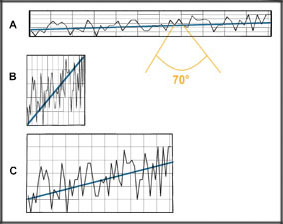|
|
Angular Readability
The visual presentation of any object is bordered by angles. The presentation of the angles can be less readable, depending on:
- shorter angle lengths
- angles that approach the 0° or 180° - axis.
In general, there is a need to differentiate between two types of angles:
- Clearly legible angles:
Clearly legible angles are perceived by taking a deep look at each element on the elementary level on a map. - The "vague" angle:
This angle can just be seen, within the entire image. For example: In a 2-D diagram this one points out the relationship between the 2 aspects of the x and y axis.
For further explanation have a closer look at the following graphic, a diagram that could be part of a legend on a thematic map:
Test your knowledge of angle readability with the following animation.
The Angle_readability

